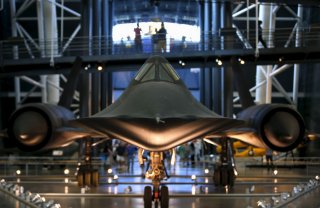The SR-71 Blackbird Is Still the Speediest Plane—Even in Retirement
The SR-71 made good use of the engines; its top recorded speed was 2193 miles per hour.
Here's What You Need to Remember: Any plane is only as fast as whatever drives it, and the SR-71 was powered by a pair of Pratt and Whitney J58 turbojet engines. The engines in question, which were used for the SR-71 as well as for its predecessor, the Lockheed A-12, were designed to fly at speeds of up to Mach 3 (more than 2000 miles per hour) at an altitude of up to 80,000 feet.
When the SR-71 Blackbird conducted its first flights in the mid-1960s, it was nothing short of amazing. It has remained so since. Over the course of its operation, the plane set dozens of speed records which have yet to be broken – and which, given the advances in satellite photography and the decreased need for fast, missile-evading spy planes, will likely stand for decades to come. While Lockheed Martin is currently working on the “SR-72,” a derivative rumored to fly at up to Mach 6 (4000 miles per hour), there has been little news about the plane for several years. Given the upheaval of the past year, and the lack of new information from Lockheed Martin’s “Skunk Works” experimental division, it seems that the SR-71’s records are safe for now.
Any plane is only as fast as whatever drives it, and the SR-71 was powered by a pair of Pratt and Whitney J58 turbojet engines. The engines in question, which were used for the SR-71 as well as for its predecessor, the Lockheed A-12, were designed to fly at speeds of up to Mach 3 (more than 2000 miles per hour) at an altitude of up to 80,000 feet. The J58 was also the first engine designed for continuous afterburner use. It is an exceptional engine, all the more so considering that it was not designed with the plane in mind.
Instead, the engine was requested by the U.S. Navy, which needed a generic engine for its open-ended Mach 2.7 Fleet Defense Interceptor project. At the time, the Navy was interested in the proposed Chance Vought XF8U-3 Super Crusader; if the Super Crusader had won the contract, the Pratt and Whitney engine would have gone to it instead.
But Clarence “Kelly” Johnson, at the time the head of Skunk Works, determined that the Pratt and Whitney engine would work for “Project Oxcart,” the program developing the Lockheed A-12. With some modifications, the engine was reworked to fit the A-12, and later the SR-71. The Super Crusader project was canceled, with five prototype aircraft built.
The SR-71 made good use of the engines; its top recorded speed was 2193 miles per hour. (In the decades since, NASA has developed an unmanned “scramjet” rocket capable of flight at Mach 9.6, or around 7000 miles per hour.)
The plane was eventually retired in the 1990s; following the fall of the Berlin Wall, defense budgets shrank, and the expensive plane was put out to pasture.
Trevor Filseth is a current and foreign affairs writer for the National Interest.
This article is being republished due to reader interest.
Image: Reuters.

